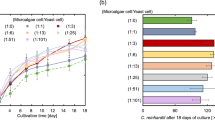Abstract
Chloroflexus aurantiacus OK-70 fl secreted 3-hydroxypropionate (3HP) during phototrophic growth. The greatest amounts were secreted by cells grown on propionate (0.35 mM 3HP) while the lowest levels were found in autotrophically grown cultures (1.5 μM). Large amounts of 2-fluoro,3-hydroxypropionate were formed by autotrophically grown cells exposed to fluoroacetate (FAc). Increased levels of 3HP were observed in these cultures when incubated with acctate. The secretion of 3HP was further stimulated by 0.2 mM KCN, an inhibitor of CO2 fixation, but only in the presence of acetate. The pathway of 3HP formation was studied by using 13C-labelled substrates and NMR. The 3HP formed in the presence of C1-labelled acetate and FAc was labelled at C3 and somewhat less at C2 while with C2-labelled acetate as the tracer 3HP was labelled predominantly at C2. The carboxyl group was derived from CO2. The 3HP formed by cells grown on propionate and 13CO2 was labelled at all carbon atoms, the label content of C2 and C3 was about 25 and 65% of that of C1 respectively. It is suggested that 3HP is an intermediate in a pathway for acetate assimilation and in a new reductive carboxylic acid cycle for autotrophic CO2 fixation.
Similar content being viewed by others
Abbreviations
- 3HP:
-
3-hydroxypropionate
- 2F3HP:
-
2,fluoro,3-hydroxypropionate
- FAc:
-
fluoroacetate
- GC:
-
gas chromatography
- MS:
-
mass spectrometry
- NMR:
-
nuclear magnetic resonance
References
Den H, Robinson WG, Coon MJ (1959) Enzymatic conversion of β-hydroxypropionate to malonic semialdehyde. J Biol Chem 234:1666–1671
Fuchs G, Stupperich E, Eden G (1980) Autotrophic CO2 fixation in Chlorobium limicola. Evidence for the operation of a reductive tricarboxylic acid cycle in growing cells. Arch Microbiol 128:64–71
Holo H, Sirevåg R (1986) Autotrophic growth and CO2 fixation of Chloroflexus aurantiacus. Arch Microbiol 145:173–180
Holo H, Grace D (1987) Polyglucose synthesis in Chloroflexus aurantiacus studied by 13C-NMR. Evidence for acetate metabolism by a new metabolic pathway in autotrophically grown cells. Arch Microbiol 148:292–297
Holo H, Grace D (1988) A new CO2 fixation mechanism in Chloroflexus aurantiacus studied by 13C-NMR. In: Olson JM, Ormerod JG, Amesz J, Trüper HG (eds) Green photosynthetic bacteria. Plenum Press, London, pp 149–155
Lowry OH, Rosebrough NJ, Farr AL, Randall RJ (1951) Protein measurements with the Folin phenol reagent. J Biol Chem 193:265–275
Nakamura K, Bernheim F (1960) Studies on malonic semialdehyde dehydrogenase from Pseudomonas aeruginosa. Biochim Biophys Acta 50:147–152
Peters RA, Wakelin RW, Rivett DEA, Thomas LC (1953) Fluoroacetate poisoning: Comparison of synthetic fluorocitric acid with the enzymically synthesized fluorotricarboxylic acid. Nature 171:1111–1112
Shively JM, Devore W, Stratford L, Porter L, Medlin L, Stevens SE (1986) Molecular evolution of the large subunit of ribulose-1,5-bisphosphate carboxylase/oxygenase (Rubisco). FEMS Microbiol Lett 37:251–257
Smiley KL, Sobolov M (1960) Metabolism of glycerol by an acrolein-forming Lactobacillus. J Bacteriol 79:261–266
Smiley KL, Sobolov M (1962) A cobamide-requireing dehydrase from an acrolein-forming Lactobacillus. Arch Biochem Biophys 97:538–543
Vagelos PR (1960) Propionic acid metabolism. J Biol Chem 235:346–350
Woese CR (1987) Bacterial evolution. Microbiol Rev 51:221–271
Yamada EW, Jakoby WB (1960) Aldehyde oxidation. J Biol Chem 235:589–594
Author information
Authors and Affiliations
Rights and permissions
About this article
Cite this article
Holo, H. Chloroflexus aurantiacus secretes 3-hydroxypropionate, a possible intermediate in the assimilation of CO2 and acetate. Arch. Microbiol. 151, 252–256 (1989). https://doi.org/10.1007/BF00413138
Received:
Accepted:
Issue Date:
DOI: https://doi.org/10.1007/BF00413138




